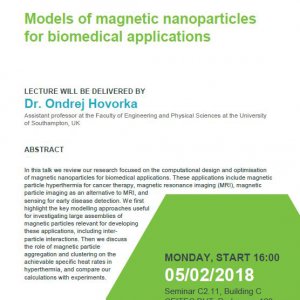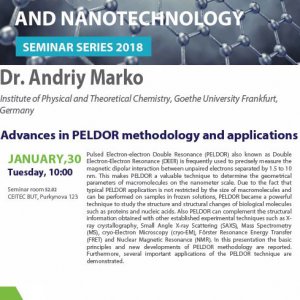
| Phone: |
+420 54949 3771 |
| Mobile: |
774436880
|
| E-mail: |
,
|
| Office: |
|
Dedication
The Centre is named after Professor Josef Dadok, a pioneer of nuclear magnetic resonance spectroscopy in Czechoslovakia and an important figure in the NMR instrumentation and methodology worldwide.
 In the 1950s, Josef Dadok and his team at the Czechoslovak Academy of Sciences developed instruments for high resolution NMR spectroscopy. Based on his design, Tesla Brno Company started industrial production of NMR spectrometers in 1965, making Czechoslovakia only the third country in the world (after the U.S. and Japan) to master the production of this sophisticated instrumentation.
In the 1950s, Josef Dadok and his team at the Czechoslovak Academy of Sciences developed instruments for high resolution NMR spectroscopy. Based on his design, Tesla Brno Company started industrial production of NMR spectrometers in 1965, making Czechoslovakia only the third country in the world (after the U.S. and Japan) to master the production of this sophisticated instrumentation.
Since late 1960s, Josef Dadok worked and lived in the USA where he became professor of chemical instrumentation at Carnegie Mellon University in Pittsburgh, PA. Among his accomplishments there is a development of the first 600 MHz (14.1 T) magnet suitable for high resolution NMR spectroscopy in 1970s.
For his achievements, Professor Josef Dadok was awarded doctor honoris causa degree by Masaryk University in 2013.
Main Activity
Core Facility of High Field NMR Spectroscopy provides access to NMR spectrometers in the range of proton frequencies from 500 MHz to 950 MHz. The equipment is suited mainly to the studies of structure, dynamics and interactions of biomolecules, i.e. proteins, nucleic acids and carbohydrates. However, the instrumentation is flexible enough to cover also various research needs in material science, organic and inorganic chemistry, biochemistry, biology and biophysics.
Unique Features
NMR (Nuclear Magnetic Resonance) spectroscopy is a key technology for research in modern life sciences allowing detailed investigation of biomolecular structure and dynamics at the atomic level, both in solutions and in solid state. The successful application of NMR in biology requires multidisciplinary approach combining knowledge in biochemistry, molecular biology, quantum physics, electronics, data analysis, and computational chemistry. The high-end instrumentation and the team of experienced researchers will ensure expert services, user training, and the cost-effective use of resources both for internal and external users. Benefits include access to state-of-the-art high-field NMR instrumentation and support in processing, analysis and interpretation of the experimental data. External user projects will be selected by peer review on the basis of scientific merit, technical suitability and feasibility. The centre will also offer training enabling non-specialists to develop the necessary skills.
Services and Methodologies Provided
-
Measurement of NMR spectra at magnetic fields ranging from 11.75 T to 22.35 T (corresponding to 1H frequencies 500 MHz to 950 MHz)
-
Consultation of choice and setup of multidimensional experiments, data processing, and evaluation strategies
-
Measurement and processing of multidimensional spectra (with up to five dimensions) of proteins using non-uniform sampling methods
-
Measurements of complete sets of very small residual dipolar couplings (RDCs) and evaluation of their accurate values supported by in-house software
-
Cross-validation of RDCs in nucleic acid bases, peptide planes, and protein secondary structure elements
-
3D structure calculations, validation of structure/restraints
-
Measurement, evaluation, and interpretation of relaxation data describing intramolecular motions
-
Ab-initio calculation of NMR parameters, molecular dynamics simulations
Key Equipment
-
950 MHz NMR spectrometer Bruker Avance III HD for high resolution spectroscopy in liquids, 4 RF channels, 5 mm triple-resonance (1H-13C-15N) inverse cryoprobe with cooled 1H and 13C preamplifiers, sample temperature range −40ºC to 80ºC
-
850 MHz NMR spectrometer Bruker Avance III HD for high resolution spectroscopy in liquids, 4 RF channels, 5 mm triple-resonance (1H/19F-13C-15N) inverse cryoprobe with cooled 1H and 13C preamplifiers, sample temperature range 0ºC to 135ºC.
-
700 MHz NMR spectrometer Bruker Avance III HD for biomolecular applications, 4 RF channels, 5 mm triple-resonance (1H-13C-15N) cryoprobe optimized for 13C detection with cooled 1H, 13C and 15N preamplifiers, sample temperature range −40ºC to 80ºC
-
700 MHz NMR spectrometer Bruker Avance III HD for multinuclear applications in liquids and solids, 4 RF channels, equipped with a 5 mm dual broad-band probe, 5 mm dual inverse broad-band probe, 1.7 mm triple resonance (1H-13C-15N) probe, 3.2 mm solid-state triple-resonance (1H-13C-15N) MAS probe, and a 4.0 mm solid-state dual CP/MAS probe
-
600 MHz NMR spectrometer Bruker Avance III HD for high resolution spectroscopy in liquids, 5 RF channels, quadruple-resonance (1H-31P-13C-15N) inverse cryoprobe with cooled 1H and 13C preamplifiers, sample temperature range −40ºC to 80ºC
-
500 MHz NMR spectrometer Bruker Avance for multinuclear applications in liquids and solids, 3 RF channels, equipped with a 5 mm nitrogen-cooled dual (BB-1H) cryoprobe (Prodigy), 5 mm room temperature triple-resonance (1H-13C-15N) probe, 10 mm dual (13C, 1H) probe, and a 4 mm solid-state dual (BB-1H) CP/MAS probe
The Core Facility is part of Czech National Affiliated Centre of INSTRUCT.
All CEITEC core facilities are available to external users (academia and companies). Czech and international researchers from universities and research institutes interested in accessing core facilities can benefit from support of research infrastructure CIISB, funded by the Ministry of Education, Youth and Sports of the Czech Republic. International researchers can also benefit from support of Project iNext.







 In the 1950s, Josef Dadok and his team at the Czechoslovak Academy of Sciences developed instruments for high resolution NMR spectroscopy. Based on his design, Tesla Brno Company started industrial production of NMR spectrometers in 1965, making Czechoslovakia only the third country in the world (after the U.S. and Japan) to master the production of this sophisticated instrumentation.
In the 1950s, Josef Dadok and his team at the Czechoslovak Academy of Sciences developed instruments for high resolution NMR spectroscopy. Based on his design, Tesla Brno Company started industrial production of NMR spectrometers in 1965, making Czechoslovakia only the third country in the world (after the U.S. and Japan) to master the production of this sophisticated instrumentation.











